- 1Department of General Surgery, Tianjin Medical University General Hospital, Tianjin, China
- 2Department of Gastroenterology, Tianjin Medical University General Hospital, Tianjin, China
Background and purpose: Hashimoto’s thyroiditis plays a crucial role in the biological behavior of papillary thyroid carcinoma. The purpose of this study was to explore the impact of Hashimoto’s thyroiditis on the preoperative evaluation of thyroid cancer.
Method: Univariate and multivariate analyses were performed to explore the clinicopathological characteristics and the risk factors for lymph node metastasis (LNM) in 2,261 patients with papillary thyroid carcinoma.
Results: The clinical data showed that the clinicopathological characteristics varied in different states of Hashimoto’s thyroiditis and levels of the thyroid peroxidase (TPO) antibody (p < 0.05). In cases without Hashimoto’s thyroiditis, the multivariate analysis showed that male sex (OR = 1.991, 95%CI = 1.574–2.517, p < 0.05) was the independent risk factor for LNM, but not in the cases with concurrent Hashimoto’s thyroiditis. The area under the receiver operating characteristic (ROC) curve of the non-Hashimoto’s thyroiditis cases was 0.727 (95% CI = 0.703–0.752, p < 0.05), while that in cases with Hashimoto’s thyroiditis was 0.632 (95% CI = 0.590–0.674, p < 0.05). Analysis of the differentially expressed genes in the different subgroups found that, in men, the differential genes among the different LNM statuses were mainly enriched in immune pathways, while in women and in younger patients, the genes were mainly enriched in cytokine and kinase pathways; in older patients, the genes were enriched in the extracellular matrix.
Conclusion: Hashimoto’s thyroiditis can affect the preoperative evaluation of thyroid cancer. In addition, sex might affect the biological behavior of papillary thyroid carcinoma, which may result from the different immune and cellular statuses among different sexes and ages.
1 Introduction
Papillary thyroid carcinoma (PTC) has become one of the most common malignant endocrine tumors, the incidence of which has increased in recent years (1, 2). At the same time, there is an increasing prevalence of Hashimoto’s thyroiditis, particularly in the youth, which is considered to be closely related to a disordered circadian rhythm (3, 4). Hashimoto’s thyroiditis is considered to be the etiology of thyroid cancer for immune-related factors (5, 6). Moreover, studies have reported that Hashimoto’s thyroiditis appears to perform a dimmorphic role in the biological behavior of PTC in that it leads to tumorigenesis while resulting in a better prognosis (7, 8). Due to the concurrence of Hashimoto’s thyroiditis, the boundary and the calcification of thyroid cancer may be misjudged under sonography (9). PTC has a high rate of lymph node metastasis (LNM), which is an aggressive marker and a prognostic indicator of the tumor. There have been numerous studies assessing the risk factors for LNM (10–12), with the conclusions being varied with a low prediction efficiency, which may have resulted from the confounded screening of participants. Our previous study found that Hashimoto’s thyroiditis and female sex were protective factors for LNM (13) and, as a consensus, that Hashimoto’s thyroiditis was biased toward the female sex (3). For these reasons, we speculated whether the influence of sex in thyroid cancer is caused by immune infiltration.
The aim of this single-center study was to analyze the impact of Hashimoto’s thyroiditis and its activity status on the assessment of LNM in order to further explore the association between sex/immune-related factors and the biological behavior of thyroid cancer.
2 Materials and methods
2.1 Clinical data
A total of 2,261 patients from 2014 to 2023 were selected, all of whom were diagnosed with PTC and underwent surgery by the same doctor. In our center, all patients diagnosed with PTC undergo routine prophylactic central compartment lymph node dissection, and the pathological results were obtained separately by two experienced pathologists. The inclusion criteria were: 1) initial PTC surgery and 2) complete clinical and pathological data. The exclusion criteria were: 1) recurrent PTC and 2) incidental PTC without central lymph node dissection (Figure 1).

Figure 1. (a, b) Receiver operating characteristic (ROC) curves of the lymph node metastasis (LNM) prediction model in non-Hashimoto’s thyroiditis cases (a) and in cases with Hashimoto’s thyroiditis (b). (c, d) ROC curves of the LNM prediction model in cases with normal thyroid peroxidase (TPO) antibody (c) and in those with high TPO antibody (d).
The cutoff age was set to 45 years, which meets the requirements of the 7th edition of the American Joint Committee on Cancer (AJCC) and conforms to the peak prevalence of autoimmune disease in women. Hashimoto’s thyroiditis was defined as lymphocytic infiltration and the formation of germinal centers combined with an elevated serum thyroid peroxidase (TPO) antibody. The TPO antibody is considered as the marker of the activity status of Hashimoto’s thyroiditis. Based on the clinical characteristics, all participants were divided as follows: aspect ratio (height divided by width, less than 1 or more than 1), margin (clear or unclear), and calcification (absent or present); preoperative serum assay: thyroid-stimulating hormone (TSH; less than or more than 2 μIU/ml), TPO antibody (normal or high, 35 IU/ml), and serum thyroglobulin (less than or more than 40 ng/ml); and postoperative pathology: tumor size (less than 1 cm, 1–2 cm, and more than 2 cm), multifocality (absent or present), bilateral tumor (absent or present), extrathyroidal extension (no capsule contacting, invading capsule, and violating surrounding tissues), Hashimoto’s thyroiditis (absent or present), nodular goiter (absent or present), and LNM (absent or present).
2.2 Public data of gene expression
We downloaded the gene expression data and clinical data of PTC from The Cancer Genome Atlas (TCGA) database (University of California, Santa Cruz; https://xenabrowser.net/) and excluded those cases without LNM information. Furthermore, 497 cases with complete age and sex information were selected, and the included genes were normally determined in at least 75% of the participants.
2.2 Statistical analysis
SPSS 22.0 software was used for analysis of the statistical data. Continuous measurement data were expressed as ± S, and univariate logistic regression analysis or the chi-square test was performed for single-factor analysis. Multivariate analysis was performed with multivariate logistic regression analysis. A p-value <0.05 indicates a statistically significant difference.
3 Results
3.1 Clinical data and single-factor analysis of LNM
According to the clinicopathological characteristics of the 2,261 cases, 667 patients had concurrent Hashimoto’s thyroiditis and 1,594 without. The average age of the patients without Hashimoto’s thyroiditis was 45.6 years, while that of patients with Hashimoto’s thyroiditis was 43.3 years (p < 0.05). Moreover, women comprised a higher proportion of patients with Hashimoto’s thyroiditis than those without, who had lower serum levels of TSH, thyroglobulin, and TPO antibody (p < 0.05). Moreover, patients with Hashimoto’s thyroiditis were more likely to have a smaller size (p < 0.05) and a lower probability of LNM; however, the difference was not significant (Table 1). In the analysis of patients with different Hashimoto’s thyroiditis statuses, it was found that patients with higher TPO antibody levels were younger and had higher TSH levels (p < 0.05). Moreover, the size of the tumor and the concurrent calcification varied in different levels of the TPO antibody; however, this did not affect LNM (Table 2).

Table 1. Clinicopathological characteristics of papillary thyroid carcinoma (PTC) in the 2,261 patients.
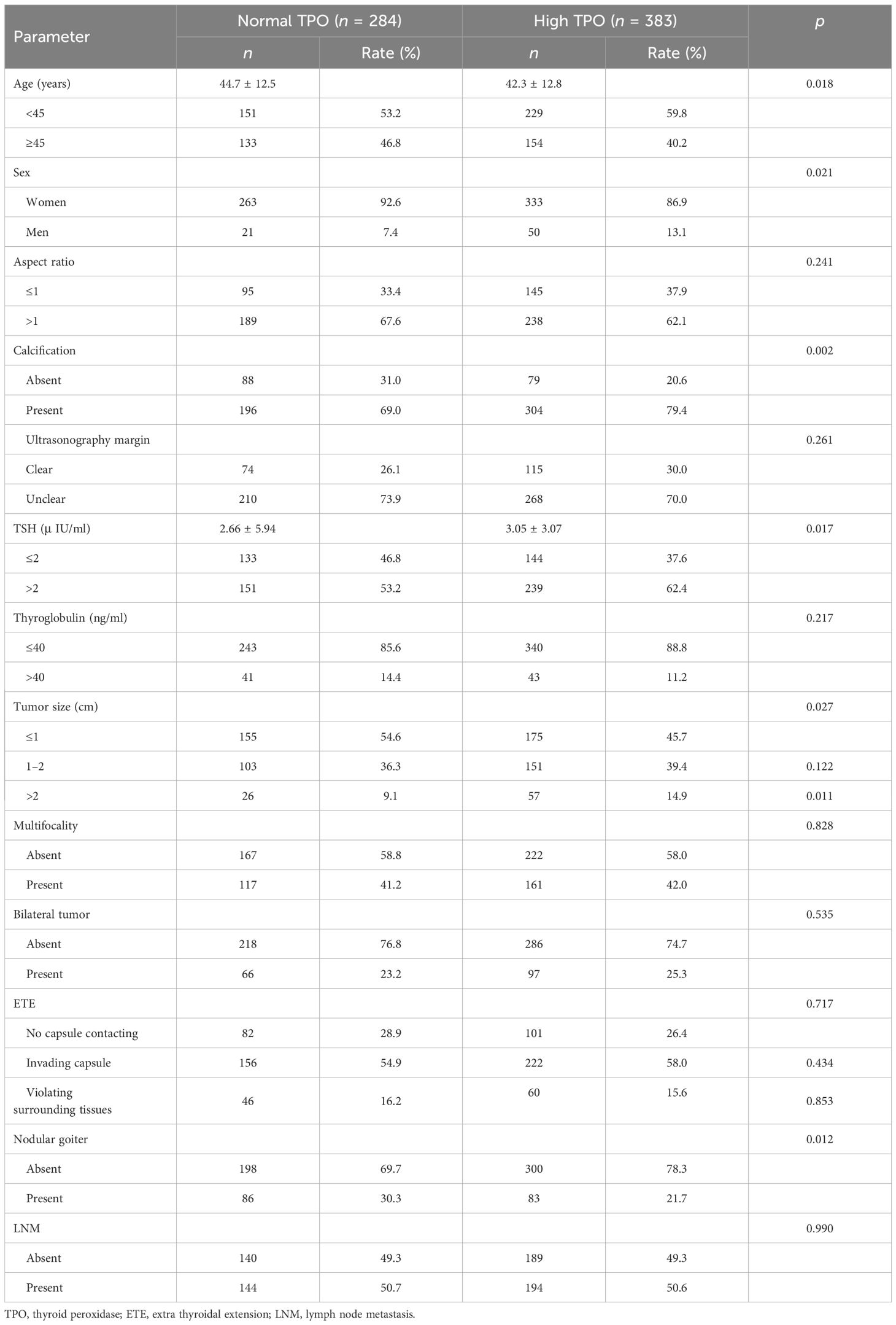
Table 2. Clinicopathological characteristics of papillary thyroid carcinoma (PTC) in the 667 Hashimoto’s thyroiditis (HT) patients.
3.2 Single-factor analysis for LNM
Univariate regression analysis was conducted for the different subgroups to explore the risk factors for LNM. Among all patients, LNM occurred in 1,051 (46.5%) cases, while 1,210 (53.5%) had no LNM. It was found that, in patients without Hashimoto’s thyroiditis, factors such as age, sex, aspect ratio, calcification, unclear margin, serum thyroglobulin, tumor size, multifocality, laterality, and capsule invasion were the risk factors (p < 0.05). On the other hand, in patients with concurrent Hashimoto’s thyroiditis, age, calcification, tumor size, laterality, capsule invasion, and the concurrence of nodular goiter were the risk factors (p < 0.05) (Table 3). Further analysis of the patients with Hashimoto’s thyroiditis with different TPO antibody levels showed that tumor size and concurrent nodular goiter were the risk factors in the group with normal TPO antibody levels (p < 0.05). In the subgroup with high TPO antibody, age, calcification, tumor size, laterality, and capsule invasion were the risk factors (p < 0.05) (Table 4).
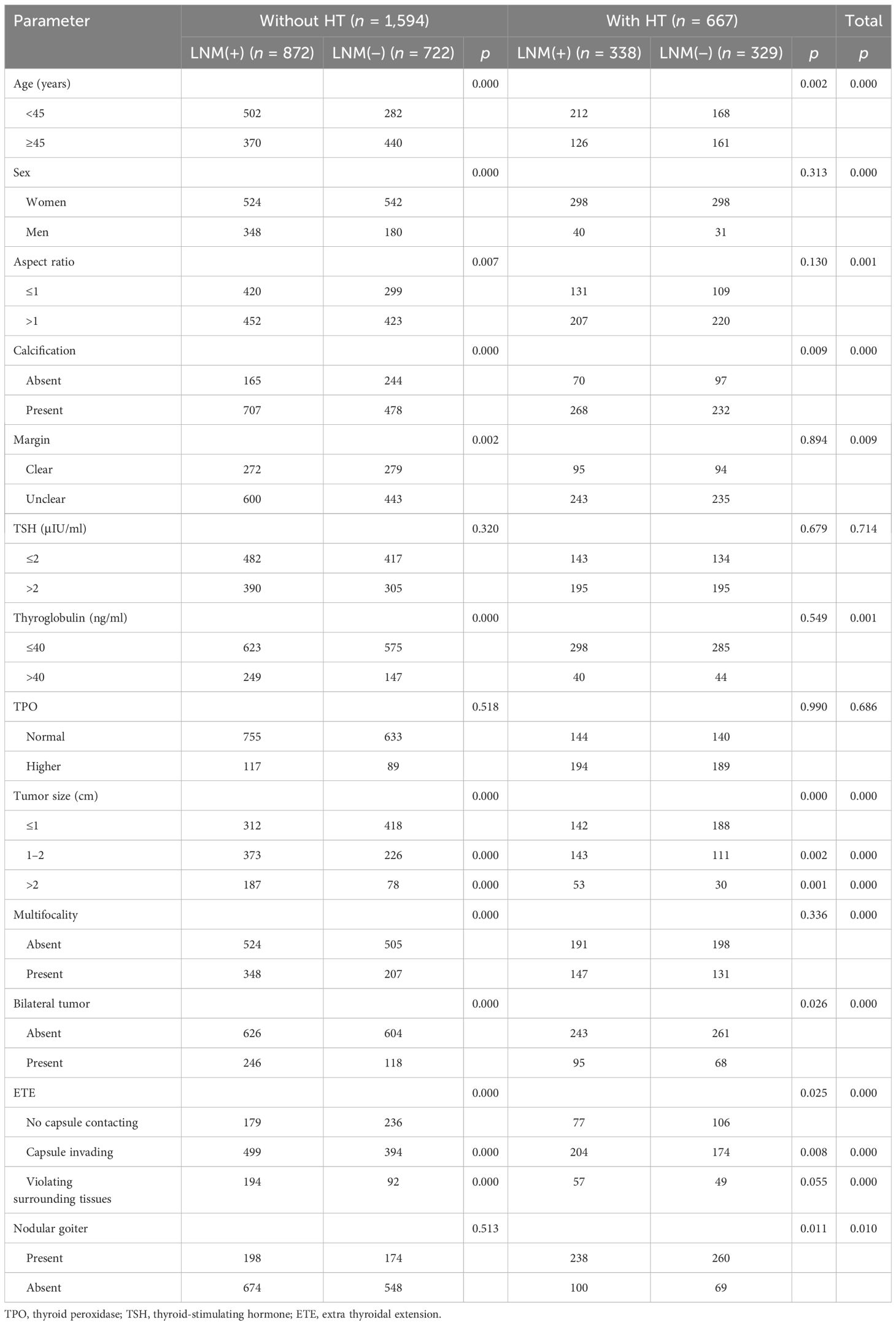
Table 3. Univariate logistic analysis of the risk factors for lymph node metastasis (LNM) in different sexes.
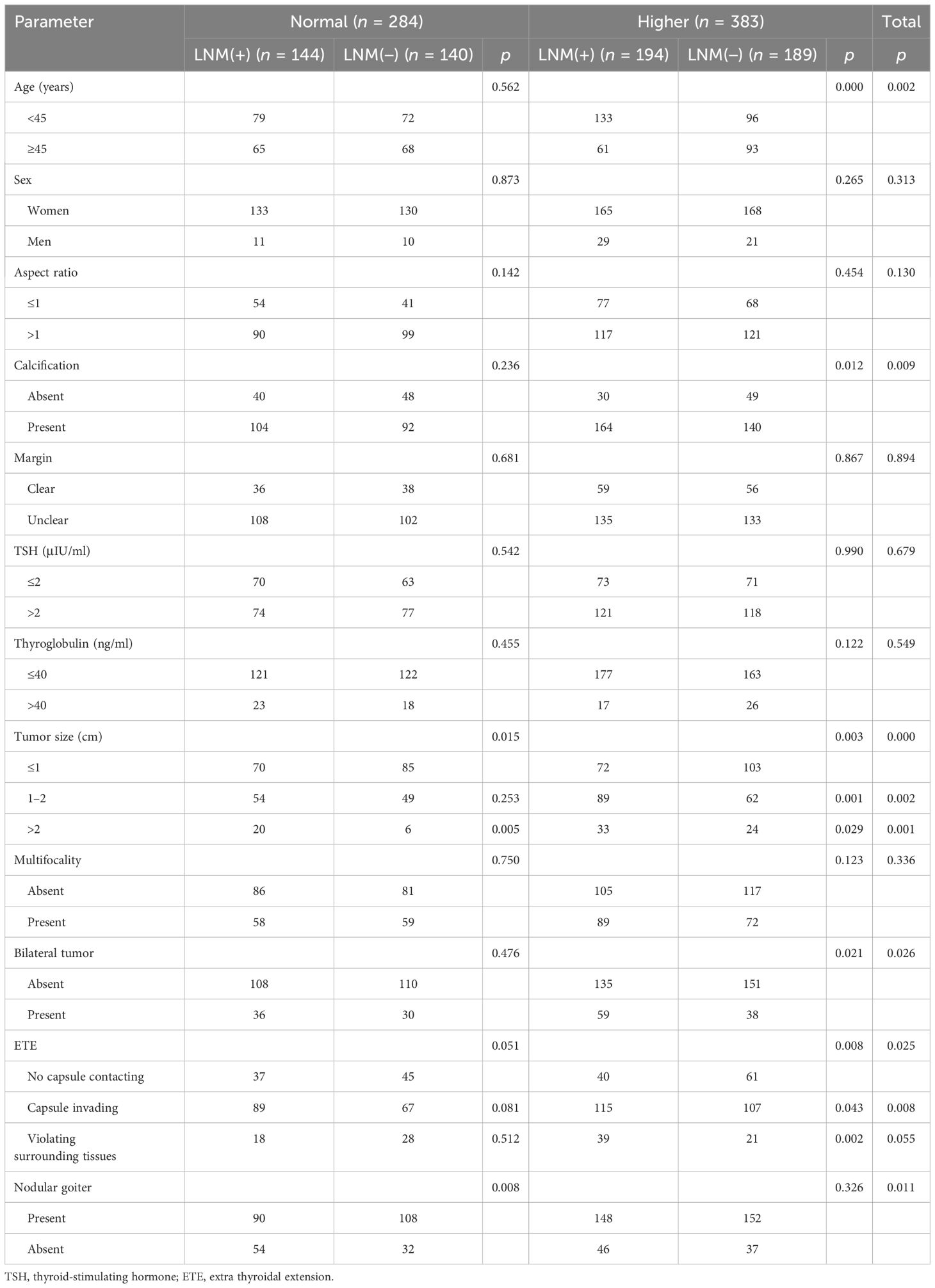
Table 4. Univariate logistic analysis of the risk factors of lymph node metastasis (LNM) in different thyroid peroxidase (TPO) statuses.
3.3 Multifactor analysis of LNM
Based on the results of the univariate analysis, the factors that may be associated with LNM (p < 0.05) were included in the multivariate logistic regression model. In cases without Hashimoto’s thyroiditis, the multivariate analysis showed that a larger size (p < 0.05), extrathyroidal extension (p < 0.05), male sex (OR = 1.991, 95%CI = 1.574–2.517, p < 0.05), younger age (OR = 2.364, 95%CI = 1.898–2.941, p < 0.05), calcification (OR = 1.823, 95%CI = 1.421–2.399, p < 0.05), laterality (OR = 1.542, 95%CI = 1.096–2.169, p < 0.05), multifocality (OR = 1.351, 95%CI = 1.009–1.808, p < 0.05), and aspect ratio (OR = 0.790, 95%CI = 0.630–0.990, p < 0.05) were independent risk factors. On the other hand, in cases with concurrent Hashimoto’s thyroiditis, a larger size (p < 0.05), extrathyroidal extension (p < 0.05), younger age (OR = 1.709, 95%CI = 1.242–2.352, p < 0.05), and concurrent nodular goiter (OR = 1.622, 95%CI = 1.123–2.341, p < 0.05) were independent risk factors. In the subgroup with normal levels of the TPO antibody, a larger size (p < 0.05) and concurrent nodular goiter (OR = 1.982, 95%CI = 1.158–3.391, p < 0.05) were the risk factors, while in patients with high levels of the TPO antibody, a larger size, extrathyroidal extension (p < 0.05), and younger age (OR = 2.183, 95%CI = 1.420–3.356, p < 0.05) were the risk factors (p < 0.05) (Table 5).
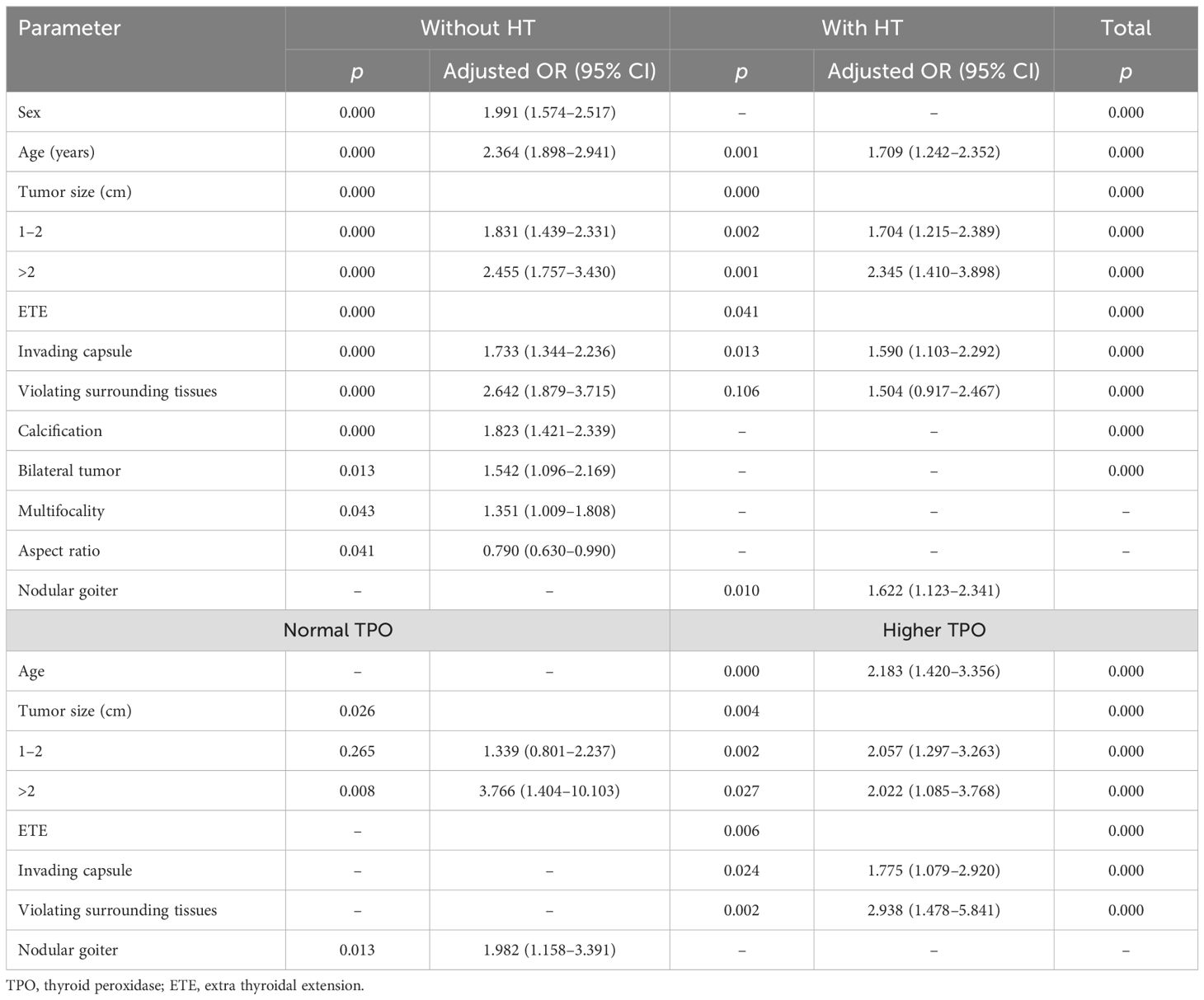
Table 5. Predictive factors for lymph node metastasis ( LNM) in patients with papillary thyroid carcinoma (PTC) in the multiple logistic regression analysis.
Based on the results of the multivariate logistic regression analysis models, a receiver operating characteristic (ROC) curve was drawn to examine the predictive efficiency of the models. The results showed that the area under the ROC curve (AUC) of the non-Hashimoto’s thyroiditis cases A was 0.727 (95% CI = 0.703–0.752, p < 0.05) (Figure 1a, line predmodel 2), while that in Hashimoto’s thyroiditis cases was 0.632 (95% CI = 0.590–0.674) (Figure 1b, line predmodel 3). In those with normal levels of the TPO antibody, the AUC C was 0.636 (95% CI = 0.572–0.699, p < 0.05) (Figure 1c, line predmodel 4), while in those with higher levels, the AUC was 0.667 (95% CI = 0.613–0.720) (Figure 1d, line predmodel 5). For the model based on the overall participants, the AUC showed similar results (Figures 1a–d, line predmodel 1).
3.4 TCGA analysis of the differentially expressed genes and gene function enrichment
The gene expression data from TCGA were applied and all subjects were classified into two groups based on sex. Analysis of the differentially expressed genes (DEGs) with different LNM statuses in the two sexes and constituting the Venn diagram by intersecting genes revealed that there were 463 shared genes, with 325 unique in men and 314 unique in women (Figure 2a). Enrolling the genes sets for Gene Ontology (GO) enrichment, it was found that the 463 shared genes were mainly enriched in the structural constituent of the extracellular matrix and the transmembrane ion channel, while the genes unique in men were mainly enriched in the immune infiltration pathway and those in women enriched in the cytokine and signaling receptor pathway (Figures 2b, e, h), which is consistent with the analysis of the protein–protein interaction networks using the GENEMANIA database (Figures 3c, f, i). In the gene set enrichment analysis (GSEA) for the different statuses of LNM, the results showed that the T -cell differentiation pathway was enriched in men and tyrosine phosphorylation enriched in women (p < 0.05) (Figures 2d, h).
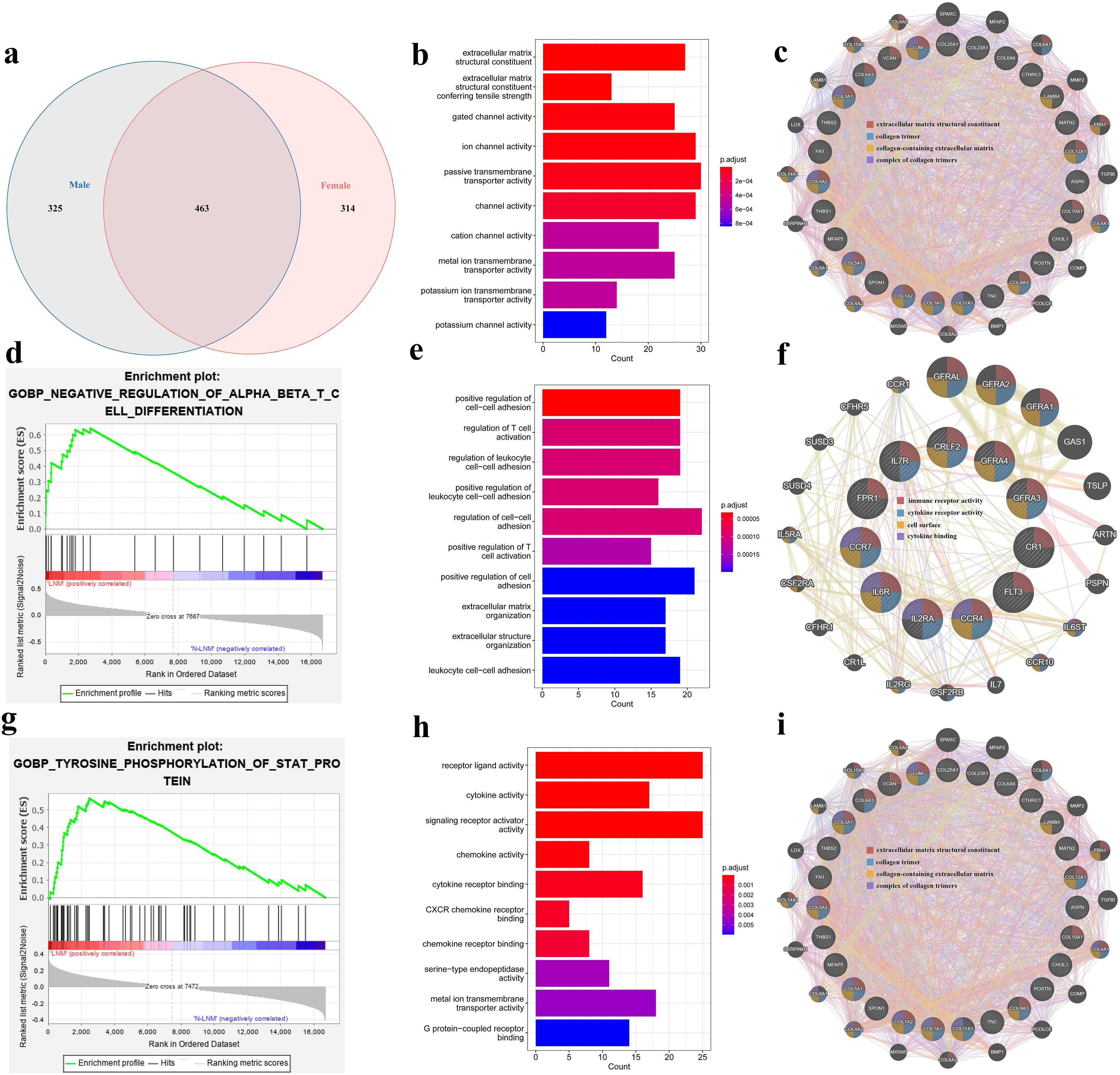
Figure 2. (a) Venn diagram of the differentially expressed genes (DEGs) in different lymph node metastasis statuses for the different sexes. (b) Gene Ontology (GO) enrichment analysis of the DEGs for the shared genes of the lymph node metastasis status in different sexes. (c) Protein–protein interaction networks of the two sexes sharing DEGs for the top one pathway of the GO enrichment analysis in the GENEMANIA database. (d, g) Gene set enrichment analysis (GSEA) of the different lymph node metastasis statuses in men (d) and in women (g). (e, h) GO enrichment analysis of the DEGs unique in men (e) and in women (h) for the different lymph node metastasis statuses. (f, i) Protein–protein interaction networks of the DEGs unique in men (f) and in women (i) for the top one pathway of the GO enrichment analysis in the GENEMANIA database.
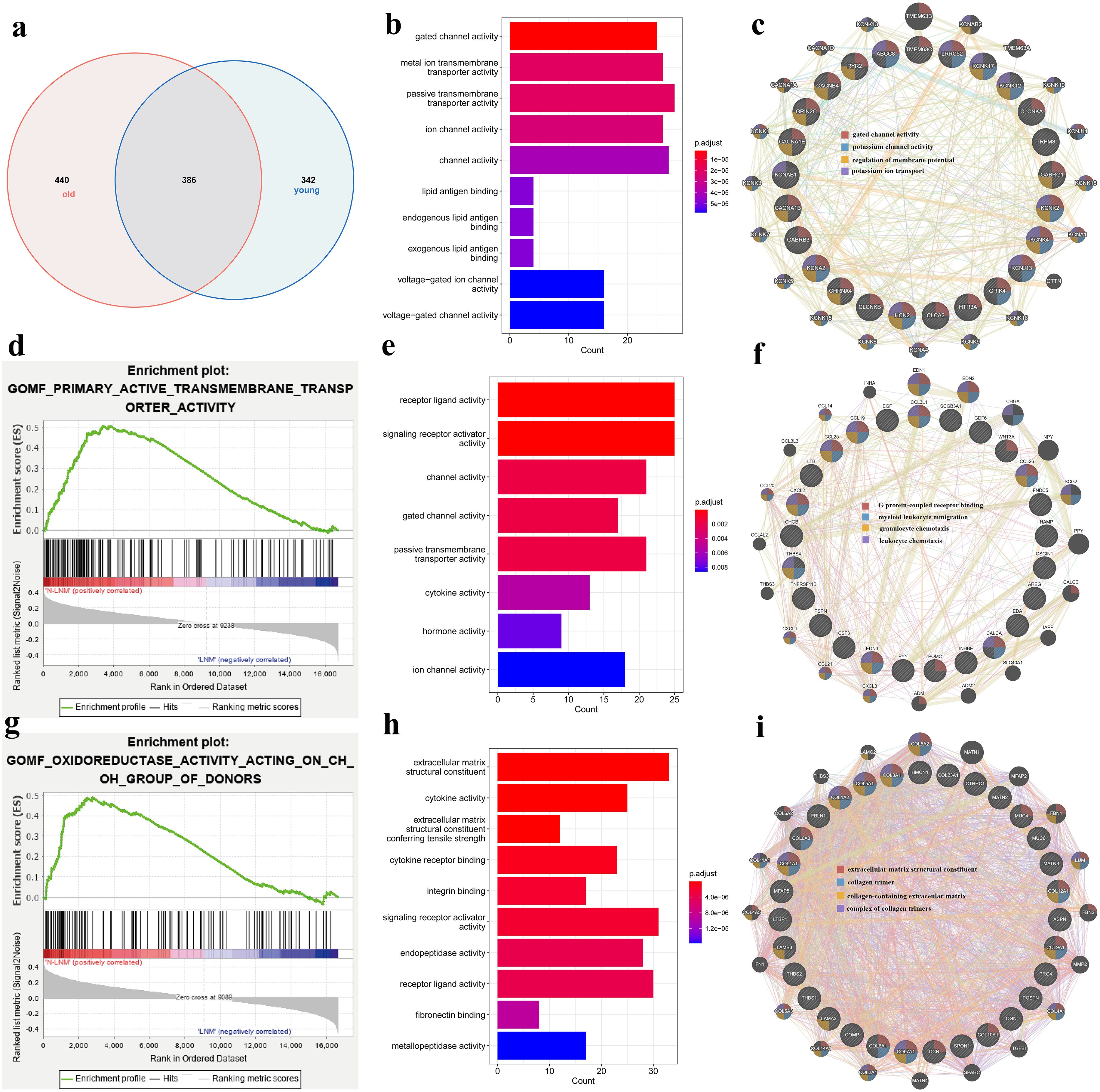
Figure 3. (a) Venn diagram of the differentially expressed genes (DEGs) in the different lymph node metastasis statuses for the different ages. (b) Gene Ontology ( GO) enrichment analysis of the DEGs for the shared genes of the lymph node metastasis status in different ages. (c) Protein–protein interaction networks of the shared DEGs for the top one pathway of the GO enrichment analysis in the GENEMANIA database. (d, g) Gene set enrichment analysis (GSEA) of the different lymph node metastasis statuses in younger (d) and in older patients (g) . (e, h) GO enrichment analysis of the DEGs unique in younger (e) and in older patients (h) for the different lymph node metastasis statuses. (f, i) Protein–protein interaction networks of the DEGs unique in younger (f) and in older patients (i) for the top one pathway of the GO enrichment analysis in the GENEMANIA database.
The Venn diagram for the different ages showed that there were 386 shared genes, with 342 unique in younger patients and 440 unique in older patients (Figure 3a). The results of GO enrichment showed that the 386 shared genes were mainly enriched in ion transmembrane channel, with the unique genes in the younger group being mainly enriched in the signaling receptor pathway and those in the older group mainly enriched in the extracellular matrix (Figures 3b, e, h). The GSEA showed that the DEGs in the younger patients were enriched in transmembrane transporter activity and those in the older patients enriched in oxidoreductase activity (Figures 3d, g, p < 0.05). This appears to be a potential mechanism to explain the different LNM patterns in the different populations.
4 Discussion
As a self-limiting disease, Hashimoto’s thyroiditis generally manifests in two states: active and resting. During the active state, the immune system attacks the thyroid gland and causes an increased level of the TPO antibody (14). Hashimoto’s thyroiditis might result in hypothyroidism at a later stage and lead to increased TSH levels, then stimulate the proliferation of tumors (15, 16). Our study found that the patients who had concurrent Hashimoto’s thyroiditis were younger, had higher levels of TSH, were smaller in size, and showed a lower possibility of LNM, which is considered as an immune response to the tumor. In general, patients with Hashimoto’s thyroiditis show a diffuse uneven and a hypoechoic sonographic appearance resulting from the infiltration of lymphocytes; at a later stage, they show a calcification change. All of these features may be misjudged as thyroid cancer (17, 18). In our research, we found that, without the background of Hashimoto’s thyroiditis, the parameters evaluated by sonography, such as calcification, aspect ratio, and multifocality, were risk factors for LNM, but were not in cases with Hashimoto’s thyroiditis. In addition, it was found that, in the absence of Hashimoto’s thyroiditis, the model had excellent predictive ability for LNM. However, with concurrent Hashimoto’s thyroiditis, it was difficult to evaluate the possibility of LNM, either in the active or the resting phase. Therefore, we suspect that it is difficult to assess the nodules in the background of Hashimoto’s thyroiditis.
Furthermore, like all autoimmune diseases, Hashimoto’s thyroiditis has a high prevalence in women, which is considered to be a consequence of female sex hormones and the inactivation of chromosome X and fetal microchimerism (19, 20). Other studies have suggested that the immune infiltration and the chronic inflammation caused by Hashimoto’s thyroiditis were the causes of thyroid cancer (21, 22). Our research found that sex was a risk factor for LNM in cases without Hashimoto’s thyroiditis; however, in cases with concurrent Hashimoto’s thyroiditis, sex was no longer a risk factor, either in the active or the resting state. It is not clear whether there is collinearity between these two factors; that is, sex factors affect LNM through the immune status. It has been reported in the literature that the impact of sex-related factors on thyroid cancer sources are from two aspects: one is the alteration of estrogen and estrogen receptors and the other is the varied immune infiltration (23). In addition, the level of thyroglobulin has been used to evaluate recurrence post -surgery. In this study, the level of thyroglobulin in serum was lower in Hashimoto’s thyroiditis, which may be due to the presence of thyroglobulin antibodies (24). The different levels of thyroglobulin can be used to evaluate LNM in cases without Hashimoto’s thyroiditis, but not in those with Hashimoto’s thyroiditis.
Analysis of the differential gene expression in the different LNM states among different genders and age groups revealed different enrichment states. We hypothesized that this difference stems from the fact that patients with thyroid cancer of different sexes and ages show varied hormone levels and immune microenvironments (25–27). This also helps in discovering new methods to prevent and treat PTC in these two aspects in the future.
This study has limitations. It is a single-center study with no external validation; hence, further multicenter studies are required to verify the findings. Furthermore, long-term follow-up is needed to compare the postoperative recurrence risk of pN1 patients with different Hashimoto’s thyroiditis statuses in order to further clarify the impact of Hashimoto’s thyroiditis on tumor recurrence.
5 Summary
Hashimoto’s thyroiditis can affect the preoperative evaluation of thyroid cancer. In addition, sex might affect the biological behavior of PTC through immune infiltration.
Data availability statement
The original contributions presented in the study are included in the article/supplementary material. Further inquiries can be directed to the corresponding authors.
Author contributions
CY: Conceptualization, Data curation, Investigation, Writing – original draft, Writing – review & editing. YZ: Conceptualization, Data curation, Investigation, Methodology, Software, Writing – original draft, Writing – review & editing. QZ: Conceptualization, Funding acquisition, Project administration, Resources, Validation, Writing – review & editing. XH: Conceptualization, Funding acquisition, Project administration, Resources, Validation, Visualization, Writing – review & editing.
Funding
The author(s) declare that no financial support was received for the research and/or publication of this article.
Acknowledgments
I would like to express my special thanks to my partners for the encouragement and support they gave me during my studies.
Conflict of interest
The authors declare that the research was conducted in the absence of any commercial or financial relationships that could be construed as a potential conflict of interest.
Generative AI statement
The author(s) declare that no Generative AI was used in the creation of this manuscript.
Publisher’s note
All claims expressed in this article are solely those of the authors and do not necessarily represent those of their affiliated organizations, or those of the publisher, the editors and the reviewers. Any product that may be evaluated in this article, or claim that may be made by its manufacturer, is not guaranteed or endorsed by the publisher.
References
1. Kitahara CM and Sosa JA. The changing incidence of thyroid cancer. Nat Rev Endocrinol. (2016) 12:646–53. doi: 10.1038/nrendo.2016.110
2. La Vecchia C, Malvezzi M, Bosetti C, Garavello W, Bertuccio P, Levi F, et al. Thyroid cancer mortality and incidence: a global overview. Int J Cancer. (2015) 136:2187–95. doi: 10.1002/ijc.v136.9
3. Ralli M, Angeletti D, Fiore M, D’Aguanno V, Lambiase A, Artico M, et al. Hashimoto’s thyroiditis: An update on pathogenic mechanisms, diagnostic protocols, therapeutic strategies, and potential Malignant transformation. Autoimmun Rev. (2020) 19:10. doi: 10.1016/j.autrev.2020.102649
4. Ragusa F, Fallahi P, Elia G, Gonnella D, Paparo SR, Giusti C, et al. Hashimotos’ thyroiditis: Epidemiology, pathogenesis, clinic and therapy. Best Pract Res Clin Endocrinol Metab. (2019) 33:6. doi: 10.1016/j.beem.2019.101367
5. Noureldine SI and Tufano RP. Association of Hashimoto’s thyroiditis and thyroid cancer. Curr Opin Oncol. (2015) 27:21–5. doi: 10.1097/CCO.0000000000000150
6. Azizi G, Keller JM, Lewis M, Piper K, Puett D, Rivenbark KM, et al. Association of Hashimoto’s thyroiditis with thyroid cancer. Endocrine-Related Cancer. (2014) 21:845–52. doi: 10.1530/ERC-14-0258
7. Issa PP, Omar M, Buti Y, Aboueisha M, Munshi R, Hussein M, et al. Hashimoto’s thyroiditis: A protective factor against recurrence in BRAF-wild type differentiated thyroid carcinoma. Cancers. (2023) 15:8. doi: 10.3390/cancers15082371
8. Lun Y, Wu X, Xia Q, Han Y, Zhang X, Liu Z, et al. Hashimoto’s thyroiditis as a risk factor of papillary thyroid cancer may improve cancer prognosis. Otolaryngology–Head Neck Surg. (2013) 148:396–402. doi: 10.1177/0194599812472426
9. Hu M, Zong S, Xu N, Li J, Xia C, Yu F, et al. The value of thyroid ultrasound computer-aided diagnosis system in the evaluation of thyroid nodules with concurrent hashimoto’s thyroiditis. J Ultrasound Med. (2021) 41:1117–24. doi: 10.1016/j.tem.2014.09.001
10. Tan L, Ji JQ, Sharen G, Liu YW, and Lv K. Related factor analysis for predicting large-volume central cervical lymph node metastasis in papillary thyroid carcinoma. Front Endocrinol. (2022) 13. doi: 10.3389/fendo.2022.935559
11. Hu Q, Zhang WJ, Liang L, Li LL, Yin W, Su QL, et al. Establishing a predictive nomogram for cervical lymph node metastasis in patients with papillary thyroid carcinoma. Front Oncol. (2022) 11. doi: 10.3389/fonc.2021.766650
12. Shao L, Wang ZH, Dong WW, Sun W, and Zhang H. Risk factors associated with preferential lateral lymph node metastasis in papillary thyroid carcinoma. Cancer Med. (2023) 12(22):20670–6. doi: 10.1002/cam4.v12.22
13. Yan C, He X, Chen Z, and Wang Y. Central compartment lymph nodes have distinct metastatic patterns in different age groups. Front Endocrinol. (2022) 13. doi: 10.3389/fendo.2022.807431
14. Antonelli A, Ferrari SM, Corrado A, Di Domenicantonio A, and Fallahi P. Autoimmune thyroid disorders. Autoimmun Rev. (2015) 14:174–80. doi: 10.1016/j.autrev.2014.10.016
15. Gabalec F, Srbova L, Nova M, Hovorkova E, Hornychova H, Jakubikova I, et al. Wpływ zapalenia tarczycy Hashimoto, stężenia TSH oraz dodatniego wyniku obecności przeciwciał przeciwtarczycowych na występowanie zróżnicowanego raka tarczycy. Endokrynologia Polska. (2016) 67:48–53. doi: 10.5603/EP.a2016.0022
16. Ferrari SM, Fallahi P, Elia G, Ragusa F, Ruffilli I, Paparo SR, et al. Thyroid autoimmune disorders and cancer. Semin Cancer Biol. (2020) 64:135–46. doi: 10.1016/j.semcancer.2019.05.019
17. Anderson L, Middleton WD, Teefey SA, Reading CC, Langer JE, Desser T, et al. Hashimoto thyroiditis: part 1, sonographic analysis of the nodular form of hashimoto thyroiditis. Am J Roentgenology. (2010) 195:208–15. doi: 10.2214/AJR.09.2459
18. Anderson L, Middleton WD, Teefey SA, Reading CC, Langer JE, Desser T, et al. Hashimoto thyroiditis: part 2, sonographic analysis of benign and Malignant nodules in patients with diffuse hashimoto thyroiditis. Am J Roentgenology. (2010) 195:216–22. doi: 10.2214/AJR.09.3680
19. Hu X, Chen Y, Shen Y, Tian R, Sheng Y, and Que H. Global prevalence and epidemiological trends of Hashimoto’s thyroiditis in adults: A systematic review and meta-analysis. Front Public Health. (2022) 10. doi: 10.3389/fpubh.2022.1020709
20. Brix TH, Hansen PS, Kyvik KO, and Hegedüs L. Aggregation of thyroid autoantibodies in twins from opposite-sex pairs suggests that microchimerism may play a role in the early stages of thyroid autoimmunity. J Clin Endocrinol Metab. (2009) 94:4439–43. doi: 10.1210/jc.2009-0813
21. Ehlers M and Schott M. Hashimoto’s thyroiditis and papillary thyroid cancer: are they immunologically linked? Trends Endocrinol Metab. (2014) 25:656–64.
22. Guarino V, Castellone MD, Avilla E, and Melillo RM. Thyroid cancer and inflammation. Mol Cell Endocrinol. (2010) 321:94–102. doi: 10.1016/j.mce.2009.10.003
23. Shobab L, Burman KD, and Wartofsky L. Sex differences in differentiated thyroid cancer. Thyroid. (2022) 32:224–35. doi: 10.1089/thy.2021.0361
24. Zhang Y, Gao Y, Li M, Xie L, Huang Y, Gao Y, et al. Avidity of thyroglobulin antibody in sera from patients with Hashimoto’s thyroiditis with different thyroid functional status. Clin Exp Immunol. (2010) 161:65–70. doi: 10.1111/j.1365-2249.2010.04155.x
25. Chen GQ, Wang YM, Qiu L, Qin XZ, Liu H, Wang XD, et al. Human IgG Fc-glycosylation profiling reveals associations with age, sex, female sex hormones and thyroid cancer. J Proteomics. (2012) 75:2824–34. doi: 10.1016/j.jprot.2012.02.001
26. Liu Q, Ma B, Song MY, Sun W, and Zhang H. Age-dependent changes in the prognostic advantage of papillary thyroid cancer in women: A SEER-based study. Clin Endocrinol. (2023) 99:342–9. doi: 10.1111/cen.14896
Keywords: papillary thyroid carcinoma, lymph nodes metastasis, Hashimoto’s, immune infiltration, sonography
Citation: Yan C, Zhao Y, Zhang Q and He X (2025) Hashimoto’s thyroiditis and its activity status influence the assessment of lymph node metastasis of thyroid cancer. Front. Endocrinol. 16:1567181. doi: 10.3389/fendo.2025.1567181
Received: 26 January 2025; Accepted: 24 April 2025;
Published: 27 May 2025.
Edited by:
Ana Valea, Iuliu Hatieganu University of Medicine and Pharmacy Cluj-Napoca, RomaniaReviewed by:
Oana Stanoiu-Pinzariu, University of Medicine and Pharmacy Iuliu Hatieganu, RomaniaGherman Lencu Codruta Claudia, University of Medicine and Pharmacy Iuliu Hatieganu, Romania
Copyright © 2025 Yan, Zhao, Zhang and He. This is an open-access article distributed under the terms of the Creative Commons Attribution License (CC BY). The use, distribution or reproduction in other forums is permitted, provided the original author(s) and the copyright owner(s) are credited and that the original publication in this journal is cited, in accordance with accepted academic practice. No use, distribution or reproduction is permitted which does not comply with these terms.
*Correspondence: Xianghui He, aGV4aDg4QHRtdS5lZHUuY24=; Qingyu Zhang, emhhbmdxeUB0bXUuZWR1LmNu
†These authors have contributed equally to this work
 Caigu Yan
Caigu Yan Yuxuan Zhao2†
Yuxuan Zhao2† Xianghui He
Xianghui He